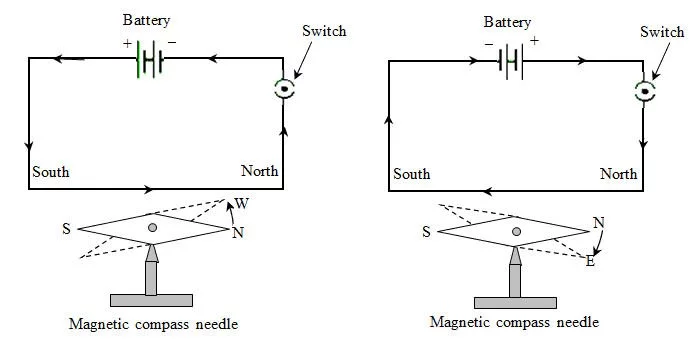Hans Christian Oersted (1777 – 1851) was a Danish scientist who is most famous for establishing a definitive relation between electricity and magnetism. Oersted’s discovery of electromagnetism proved to be hugely influential leading to much later work in the field and providing the basis for numerous technological inventions. Apart from his contributions to physics, Oersted also did some ground-breaking work in chemistry. His most significant achievements in chemistry is being the first person to isolate the element aluminum and the chemical compound piperine. Know more about the achievements of Hans Christian Oersted through his 7 major contributions.
#1 HE WAS FIRST TO ESTABLISH A CONNECTION BETWEEN ELECTRICITY AND MAGNETISM
In 1800, Alessandro Volta invented the voltaic pile, the first electrical battery. The following year, Oersted began to investigate the nature of electricity and to conduct his first electrical experiments. In 1820, while performing classroom demonstrations for his university students, Oersted passed electric current through a wire which caused a movement in the needle of a magnetic compass placed nearby. This clearly established a relationship between magnetism and electricity making Oersted the first to identify the force of electromagnetism. His discovery was published in July 1820, in a pamphlet titled “Experiments on the Effect of a Current of Electricity on the Magnetic Needle”. Through further experimentation, Oersted also found that electric current produces a circular magnetic effect around it.

#2 HIS DISCOVERY OF ELECTROMAGNETISM PAVED THE WAY FOR NUMEROUS INVENTIONS
Oersted’s discovery of electromagnetism unleashed a series of discoveries that eventually laid the foundation for our modern technology-enabled world. Soon after Oersted’s discovery, French physicist Andre-Marie Ampere developed a single mathematical formula to represent the magnetic forces that exist between current-carrying conductors. Then, over 40 years later, Scottish scientist James Clerk Maxwell modified this equation so that it would also apply to situations in which the current is not constant. In this form it became one of his four famous equations establishing that light is an electromagnetic wave. Electromagnetism is the basis for numerous devices including electric motor, microphone, electric generator, loudspeaker and transformers.

#3 HIS LAW FORMs THE BASIS OF THE EQUATIONS THAT GOVERN ELECTROMAGNETISM
Oersted’s Law, named after Hans Oersted, is a law in electromagnetism that states that when a steady electric current passes through a wire it creates a magnetic field around it. Oersted’s Law is one of two laws that link electricity to magnetism, the other is Faraday’s Law of Induction. Oersted’s Law and Faraday’s Law later became part of the equations that govern electromagnetism. These are the four equations mentioned earlier, known as Maxwell’s Equations.

#4 HE WAS THE FIRST TO ISOLATE PIPERINE
Hans Oersted had a pharmacological background and he also performed experiments in chemistry. In 1819, a year before he discovered electromagnetism, Oersted became the first person to discover the chemical compound Piperine. Piperine is a naturally occurring organic compound that is responsible for the pungency of black pepper and long pepper. Oersted isolated Piperine from the fruits of Piper nigrum, the source plant of both black and white pepper.

#5 HE WAS THE FIRST CHEMIST TO ISOLATE ALUMINUM
Aluminum is one of the most plentiful elements on earth. However, it is always combined with other elements. Many chemist thought that aluminum existed and there were numerous attempts to uncover it. However, it was Hans Oersted who became the first person to isolate aluminum in 1825. He reacted aluminum chloride (AlCl3) with potassium amalgam (an alloy of potassium and mercury). He then heated the resulting mixture under reduced pressure. This caused the mercury to boil away leaving behind an impure sample of aluminum metal. The isolation of aluminum is regarded as the most significant contribution of Oersted to chemistry.
#6 HE WAS FIRST MODERN THINKER TO NAME THE THOUGHT EXPERIMENT
A thought experiment is the act of reasoning through to the practical outcome of a hypothesis when physical proof is unavailable or unattainable. It involves asking the question “what if” and then reasoning out the answer through a series of logical steps. Thought experiments were famously used by Albert Einstein to help him arrive at his theory of relativity. Hans Oersted was the first modern thinker to explicitly describe and name the thought experiment. Moreover, in c. 1812, he used the Latin-German term Gedankenexperiment; and in 1820, he used the German term Gedankenversuch to describe a thought experiment.

#7 HE FOUND THE FIRST POLYTECHNIC OF DENMARK
In 1824, Oersted found the Society for the Dissemination of Natural Science, an organization dedicated to making science accessible to the public. The society still remains active and presents the H. C. Oersted Medal for scientific achievement. In 1829, Oersted also founded the College of Advanced Technology in Copenhagen, Denmark. It was Denmark’s first polytechnic. Today known as the Technical University of Denmark, it is ranked among Europe’s leading engineering institutions.

MAJOR AWARDS AND HONORS
In 1820, the British Royal Society awarded Oersted the Copley Medal, the greatest prize in science at the time, for his discovery of electromagnetism. In 1930, to commemorate Oersted’s contribution to electromagnetism and the impact it had on Physics as a discipline, the unit of the auxiliary magnetic field H in the CGS system of units was named oersted (symbol Oe). It equals 1 dyne per maxwell.


Wow